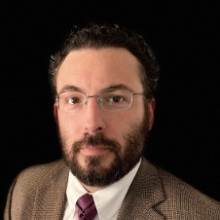-
Title
Group Leader -
Email
watts24@llnl.gov -
Phone
(925) 422-3880 -
Organization
ENG-CED-COMPUTATIONAL ENGINEERING
Professional Experience
Dr. Watts completed his PhD in mechanical engineering at the University of Illinois in 2013, specializing in design of multi-physics meta-materials with topology optimization. After completing a post-doctoral appointment at Illinois, he joined LLNL's Computational Engineering Division (CED) in 2016. His work since then has been primarily in research and development, focusing on design of micro-architected materials to be fabricated with advanced manufacturing methods; design of meta-materials for extremal properties; optimization of additive manufacturing processes; and development of design optimization software. He has been leading development of LiDO, the Livermore Design Optimization code, since 2020. In 2023, he was named the group leader for the new Generative Design & Optimization Group within CED.
Prior to graduate school, he spent several years working at the Knolls Atomic Power Laboratory in upstate New York, concentrating on fatigue and fracture design rules for new and in-service reactor heavy equipment. As an undergrad, he worked in a research group that performed x-ray diffraction experiments on deforming polycrystals.
Research Interests
Dr. Watts' main research focus is on design optimization, particularly of mechanical systems including multi-material and multi-scale meta-materials, but including physical and non-physical systems generally. Related interests are numerical modeling and simulation, mainly using finite element methods; optimization from the mathematical perspective; and high-performance computing. Interests farther afield include meshing; computational geometry and topology; graph theory; and machine learning.
Ph.D., Mechanical Engineering, University of Illinois at Urbana-Champaign, Urbana, Illinois
M.S., Mechanical Engineering, University of Illinois at Urbana-Champaign, Urbana, Illinois
B.S., Mechanical and Aerospace Engineering, Cornell University, Ithaca, New York
Daniel A. White, Jun Kudo, Kenneth Swartz, Daniel A. Tortorelli, and Seth Watts, “A reduced order model approach for finite element analysis of cellular structures,” Finite Elements in Analysis and Design 214, 103855, 2023.
Anil N. Hirani, Kaushik Kalyanaraman, Han Wang, and Seth Watts. “Computing discrete harmonic differential forms in a given cohomology class using finite element exterior calculus.” Computational Geometry 109, 101937, 2023.
Jenmy Zhang, Adrian Butscher, Seth Watts, and Daniel A. Tortorelli. “Anisotropic yield models for lattice unit cell structures exploiting orthotropic symmetry,” Computer Methods in Applied Mechanics and Engineering 394, 114935, 2022.
Seth Watts, “Elastic response of hollow truss lattice micro-architectures,” International Journal of Solids and Structures 206, 472-564, 2020.
Felipe Fernandez, Andrew T. Barker, Jun Kudo, James P. Lewicki, Kenneth Swartz, Daniel A. Tortorelli, Seth Watts, Daniel A. White, and Jonathan Wong, “Simultaneous material, shape and topology optimization,” Computer Methods in Applied Mechanics and Engineering 371, 113321, 2020.
Seth Watts, “Flaw tolerance of octet truss lattices with random flaws,” Technical Report LLNL-TR-808118, 2020.
Seth Watts, William Arrighi, Jun Kudo, Daniel A. Tortorelli, and Daniel A. White, “Simple, accurate surrogate models of the elastic response of three-dimensional open truss micro-architectures with applications to multiscale topology design,” Structural and Multidisciplinary Optimization 60 (5), 1887-1920, 2019.
Wen Chen, Seth Watts, Julie A. Jackson, William L. Smith, Daniel A. Tortorelli, and Christopher M. Spadaccini, “Stiff isotropic lattices beyond the Maxwell criterion,” Science Advances 5 (9), eaaw1937, 2019.
Daniel A. White, William J. Arrighi, Jun Kudo, and Seth Watts, “Multiscale topology optimization using neural network surrogate models,” Computer Methods in Applied Mechanics and Engineering 346, 1118-1135, 2019.
Seth Watts and Daniel A. Tortorelli, “A geometric projection method for designing three‐dimensional open lattices with inverse homogenization,” International Journal for Numerical Methods in Engineering 112 (11), 1564-1588, 2017.
Christian Barbarosie, Daniel A. Tortorelli, and Seth Watts, “On domain symmetry and its use in homogenization,” Computer Methods in Applied Mechanics and Engineering 320, 1-45, 2017.
Seth Watts and Daniel A. Tortorelli, “Optimality of thermal expansion bounds in three dimensions,” Extreme Mechanics Letters 12, 97-100, 2017.
Seth Watts and Daniel A. Tortorelli, “An n‐material thresholding method for improving integerness of solutions in topology optimization,” International Journal for Numerical Methods in Engineering 108 (12), 1498-1524, 2016.
Anil N. Hirani, Kaushik Kalyanaraman, and Seth Watts, “Graph Laplacians and least squares on graphs,” IEEE International Parallel and Distributed Processing Symposium Workshop, 812-821, 2015.
Anil N. Hirani, Kaushik Kalyanaraman, Han Wang, and Seth Watts, “Cohomologous harmonic cochains” on ArXiv, arxiv.org/abs/1012.2835, 2012.
Xinyu Zhang, Seth Watts, Yaohang Li, and Daniel A. Tortorelli, “Minkowski functionals study of random number sequences,” International Conference on Computational Science, 550-559, 2009.
Jay C. Schuren, Seth Watts, Jun-Sang Park, and Matthew P. Miller, “A system for measuring crystal level stresses in deforming polycrystals,” Proceedings of the 2007 SEM Annual Conference and Exposition on Experiential and Applied Mechanics, 5-14, 2007.


